Bringing a new puppy into your home is an exciting time, filled with joy and new adventures. One of the most fundamental and crucial steps for ensuring a harmonious life together is mastering the art of potty training. Learning effective tricks to potty training a puppy at the right time and in the right places lays the groundwork for a happy, healthy relationship. Before your furry friend even crosses the threshold, it’s vital to research proven house training methods, decide what best suits your lifestyle, and formulate a clear action plan. This comprehensive guide will equip you with the best strategies and expert advice to navigate the puppy potty training journey with confidence.
Why Potty Training Your Puppy is Essential
From learning their name to mastering basic obedience commands, the list of skills your new puppy needs to acquire can feel overwhelming. However, when prioritizing these lessons, housetraining should undoubtedly rank at the top of your agenda. It’s more than just preventing messes; it’s about establishing good habits and building a strong bond.
Potty training provides a vital foundation for appropriate behavior, enabling your puppy to establish a predictable routine and, crucially, keeps your home clean and free from unwanted odors. Successfully teaching your puppy where and when to relieve themselves is key to fostering a positive relationship, setting both of you up for training success, and enjoying a long, fulfilling life together. For more comprehensive guidance, explore other puppy potty training tips and tricks to ensure a smooth transition for your new companion.
Effective Potty Training Methods: Tried-and-True Strategies
According to Dr. Mary Burch, director of the AKC’s Canine Good Citizen and S.T.A.R. Puppy programs, there are well-established methods for training your puppy. While each approach has its own advantages and disadvantages, all can lead to success if you adhere to a few core principles. Understanding these different strategies allows you to choose the best fit for your puppy and household.
Harnessing the Power of Crate Training
Dog crates are an invaluable tool for many aspects of puppy care, and potty training is no exception. It’s highly beneficial to get your dog comfortable with a crate for various reasons, including vet visits and travel, making it easier to integrate into their routine.
Dogs are naturally den animals, instinctively seeking out a secure, cave-like space. This inherent behavior makes it relatively straightforward to train your dog to love their crate. The fundamental principle behind using a crate for housetraining is rooted in a dog’s natural cleanliness. Dogs inherently dislike soiling their immediate living area. Therefore, the crate must be appropriately sized – just large enough for your puppy to stand up, turn around, and lie down comfortably. If the crate is too spacious, your puppy might use one corner as a bathroom area and then settle down away from the mess, defeating the purpose. Many modern crates come with partitions, allowing you to adjust the size as your puppy grows.
When they feel the urge to eliminate, a puppy will typically signal this need by whining, scratching, or restlessness. This is their urgent signal to you that they need to go out! If you allow your puppy to have accidents within their crate, they will learn that it’s acceptable to relieve themselves in their living space. This can unfortunately translate to them feeling comfortable leaving messes around your home as well.
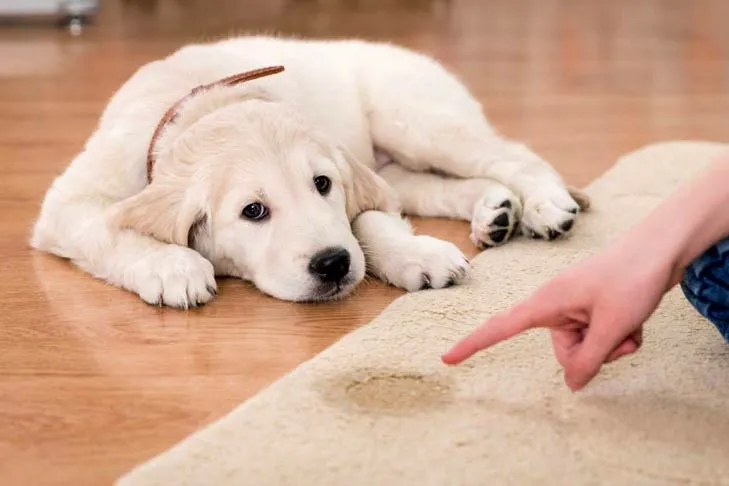 Golden Retriever puppy looking guilty after an indoor potty accident on a rug
Golden Retriever puppy looking guilty after an indoor potty accident on a rug
The Nuances of Puppy Pads and Paper Training
Dr. Burch cautions that using puppy pads or engaging in paper training can be somewhat complex. She explains, “You’re reinforcing two different options for the puppy.” Ideally, puppies learn to hold their bladder indoors and only eliminate in specific outdoor spots. However, certain circumstances might necessitate a more flexible approach, such as for individuals with demanding work schedules that prevent frequent outdoor trips, or for tiny dog breeds living in areas with harsh winter weather.
Puppy pads offer the option for a dog to relieve themselves in an approved indoor location. There are also indoor dog potty systems, some specifically designed to accommodate male dogs. Once the dog matures, owners can then transition to training them to do their business exclusively outdoors.
Establishing a Consistent Potty Training Schedule
Consistency is absolutely critical to success when creating a housetraining schedule for your puppy. Puppies have small bladders and immature digestive systems, meaning they process food and water quickly. You must provide them with ample opportunities to relieve themselves in the designated spot.
A helpful guideline suggests that puppies can typically control their bladder for the number of hours corresponding to their age in months, up to approximately 9 months to a year. So, a 6-month-old puppy might reasonably be expected to hold it for about 6 hours. However, remember that 10 to 12 hours is a long time for any living creature to hold it! It’s crucial to acknowledge that every puppy is an individual, and their timing will vary.
To set up an effective schedule, carefully monitor your puppy’s daily habits and patterns. For very young puppies, you should anticipate taking them out frequently:
- First thing in the morning and immediately before bedtime.
- After periods of indoor play.
- Upon waking from a nap or after spending time in their crate.
- After eating, drinking, or chewing on a toy or bone.
This intensive schedule might mean you’re rushing to the puppy pad, backyard, or street a dozen or more times within a 24-hour period. If you work outside the home, make arrangements to maintain this schedule, perhaps by hiring a dog walker or enlisting a trusted friend or neighbor to help your dog get outside for potty breaks. The quicker you instill the understanding that there’s an approved potty spot and that other areas are off-limits, the faster you can move past this often-messy phase. For more practical tips and tricks for potty training a puppy, consistency and patience are your best allies.
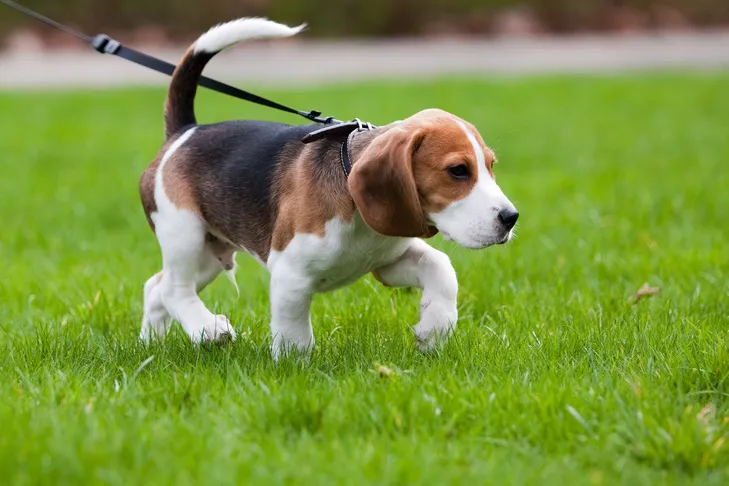 A Beagle puppy on a leash walking in green grass, learning outdoor potty habits
A Beagle puppy on a leash walking in green grass, learning outdoor potty habits
The Art of Observation and Supervision
Successful potty training heavily relies on your ability to closely observe your puppy for their individual signals and rhythms. Some puppies may possess greater bladder control than others, while some might need to go out every time they play or become excited. You may even encounter puppies who pause mid-play, relieve themselves, and then immediately resume playing. Much like human babies, canine potty habits are highly individualistic and often idiosyncratic. Vigilant supervision allows you to catch these cues early and prevent accidents.
Managing Your Puppy’s Diet for Better Potty Habits
Puppies have immature digestive systems, meaning they struggle to process large quantities of food at once. This is why it’s commonly recommended to divide your puppy’s daily feeding schedule into three smaller meals. Beyond quantity, the quality of the food itself is paramount; choose a high-quality puppy food that agrees with your specific puppy.
Regularly examining your dog’s stool is often the best way for an owner to determine if a diet change is necessary. If your puppy consistently produces stools that are bulky, loose, or particularly odorous, it might be time to consult your veterinarian. They may advise [switching to a new dog food]. Overfeeding can also lead to diarrhea, which will only make the already challenging task of housetraining significantly more difficult.
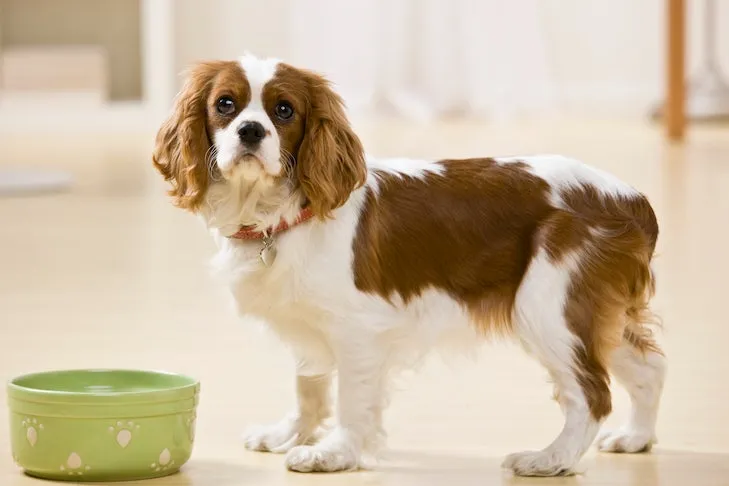 Cavalier King Charles Spaniel puppy standing next to its food bowl, emphasizing diet's role in potty training
Cavalier King Charles Spaniel puppy standing next to its food bowl, emphasizing diet's role in potty training
The Power of Positive Reinforcement: Rewarding Outdoor Success
Scolding a puppy for soiling your rug, especially if it happens well after the fact, is generally ineffective. Instead, praising a puppy enthusiastically for doing the right thing yields the best results for all aspects of your life together. Make them feel like a canine prodigy every time they successfully perform this simple, natural act outdoors.
Be effusive in your praise – cheer, clap, offer their favorite small, easy-to-digest treats. Let them know that no other accomplishment, ever, has been as significant as this successful potty break. If your dog [has an accident] indoors, do not make a fuss. As Dr. Burch advises, simply clean up the mess calmly. Use an enzymatic cleaner that effectively eliminates odors to remove any lingering scent, which prevents your dog from being drawn back to that spot in the future. Blot up any liquid on the carpet before applying the cleaner.
If you catch your dog in the act of squatting to urinate or defecate indoors, immediately pick them up and rush them outside. If they successfully finish their business outdoors, shower them with praise and attention. Remember, when it comes to housetraining, prevention and [positive reinforcement] are the most powerful and effective tools. Consistent positive reinforcement, alongside a good routine, also contributes to developing good sleeping habits. While the focus here is on potty training, many of these efforts combine to help with tricks to get your puppy to sleep through the night.
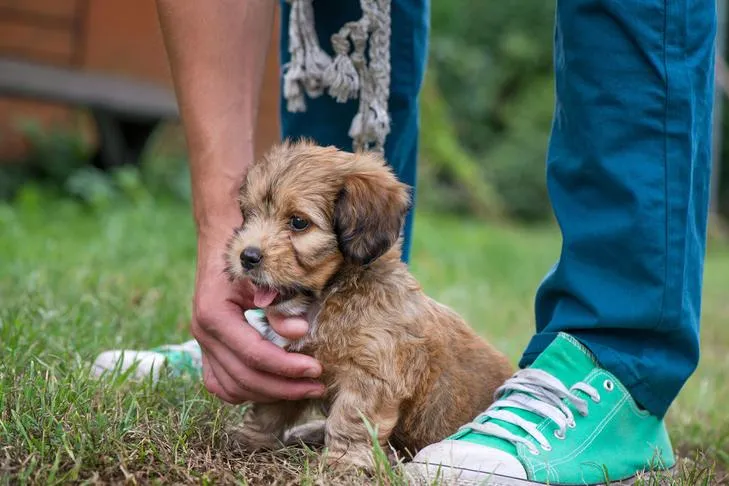 A small puppy sitting on green grass during an outdoor potty training session
A small puppy sitting on green grass during an outdoor potty training session
Troubleshooting Common Potty Training Challenges
While adhering to these rules generally leads to a well-house-trained puppy, sometimes the process doesn’t go as smoothly as planned.
Dr. Burch points out that sometimes house soiling can indicate an underlying physical issue. “Well before the several-month mark, a dog who has seemed impossible to housetrain should have a thorough veterinary workup,” she states. If your vet confirms your dog is healthy, the next step is to seek out a certified trainer or a veterinary behaviorist experienced in addressing such issues.
Here are some common complaints encountered by trainers and how to address them:
“My Puppy Piddles Everywhere!” (Common with Toy Breeds)
This complaint is particularly common among owners of Toy breeds. Some trainers suggest teaching these smaller puppies to use designated indoor potty spots, similar to how a cat uses a litter box. Beyond puppy pads, there are actual dog potty boxes designed for indoor use. Trainers emphasize that with best tricks to potty train a puppy and unwavering consistency, even the smallest dogs can be successfully house-trained, though it might require a bit more time, attention, and dedicated effort.
“They Keep Using the Same Spot for Accidents!”
This problem often arises because the previous mess wasn’t cleaned thoroughly enough. A lingering odor can signal to your dog that this particular spot is still an acceptable place to relieve themselves. Ensure your new puppy supply kit includes plenty of pet stain enzymatic cleaners and meticulously follow their instructions. These cleaners break down odor-causing molecules, completely removing the scent that might attract your puppy back to the same spot.
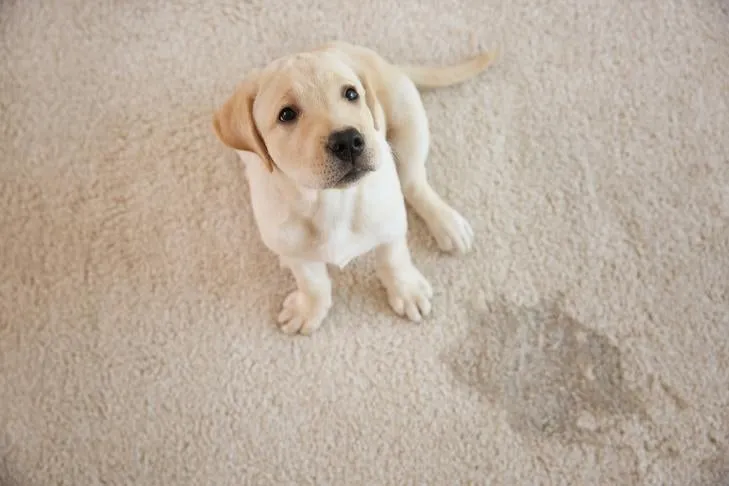 A Yellow Labrador Retriever puppy sitting on a carpet next to a urine stain, highlighting the need for thorough cleaning
A Yellow Labrador Retriever puppy sitting on a carpet next to a urine stain, highlighting the need for thorough cleaning
“I Gave Them Too Much Freedom Too Soon!”
This is a very common mistake among new dog owners. They observe some early signs that their puppy is beginning to understand, and they declare victory prematurely. Even when your puppy starts consistently doing what you want, it’s crucial to stick to their established schedule to ensure these good habits become deeply ingrained and reliable. Gradually increase their freedom only after a long period of consistent success.
“My Puppy is Soiling Their Crate!”
Dr. Burch notes that rescued dogs who have experienced long periods of confinement with no other option but to eliminate in their kennels will often soil their crates. The most effective approach in such cases is to restart crate and house training from the very beginning. Here are the steps to follow:
- Assess your dog’s ability to control their bladder and bowels when they are not in the crate.
- Carefully manage and control their diet and feeding schedule.
- Provide very frequent trips outside, including immediately after every meal, first thing in the morning, and just before bedtime.
- If you work or will be away from home for extended periods, arrange for a dog walker or a trusted neighbor or friend to let your dog out for potty breaks.
- If your puppy does have an accident, always clean everything thoroughly to ensure no odors remain.
How Long Does Puppy Potty Training Typically Take?
The duration required for potty training can vary considerably, as Dr. Burch emphasizes. Many factors influence this timeline, including the puppy’s age, their previous learning experiences (or lack thereof), and the consistency and methods employed by the owner. An 8-week-old puppy is developmentally very different from a 5-month-old puppy. Some puppies may achieve perfect house manners in just a few days, while others might take several months, particularly if they came from a less-than-ideal situation before joining your family.
Despite these variables, with consistent patience and persistent effort, most dogs can successfully learn proper housetraining.
Embracing the journey of potty training your puppy requires dedication, understanding, and a consistent approach. By implementing these expert-backed methods, maintaining a diligent schedule, observing your puppy’s cues, and reinforcing positive behaviors, you are setting your furry friend up for lifelong success. Remember that every puppy is unique, so tailor your efforts to their individual needs and celebrate every small victory along the way. Your commitment to proper housetraining will forge a stronger bond and lead to a more joyful, mess-free life together.
